Oslo’s new "it" place is as alluring to travelers as it is to locals. See what the fuss is about at this five-star Art Deco hotel.
Travel is transportive. We remove ourselves from the familiar, often with the intent of being transplanted someplace blissfully foreign. And yet, if design is the fabric of a culture’s DNA, have you noticed a neutralization take hold? The interiors of institutional buildings the world over have been stripped of their sense of place. A luxury hotel and a trending new restaurant half-way around the world can imbue the same feel and aesthetic as one down the street. But, amid a hodgepodge of boilerplate hotels, stands Sommerro, a portal to Norway circa the 1930s. It’s escapism at its most visually arresting.
Sommerro Overview: An Homage to Norway
At a glance, Sommerro is an Art Deco hotel within the Preferred Hotels & Resorts portfolio. It houses 231 rooms and 56 branded residences, seven restaurants and bars, a gilded theatre, a rooftop pool, and a full gym and spa.
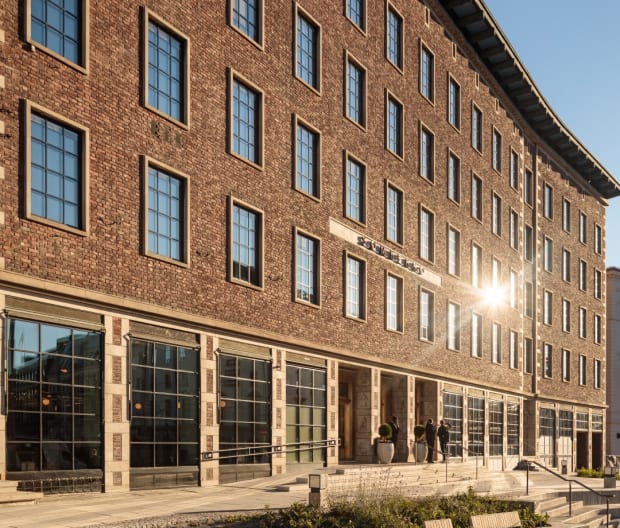
Francisco Nogueira
Sommerro’s rather stately exterior—a hand-hammered red brick façade sporting a flat roof—doesn’t hint at the splendor inside. It is, however, representative of the building’s origins as the former headquarters of Oslo Lysverker, the city's electrical company.
Designed in 1931 by revered architects Andreas Bjercke and Georg Eliassen, it was neo-classical at its core with timber wall panels and functional, clean lines. That's not to say there weren't any flourishes. Gjellebekk marble stairs and terrazzo floors stretched through the property, and bas-reliefs carved into stone pillars by sculptor Asbjørg Borgfelt still greet you at the entrance. In fact, much of its former glory within the bath, foyer, hall, and circular staircase remains.
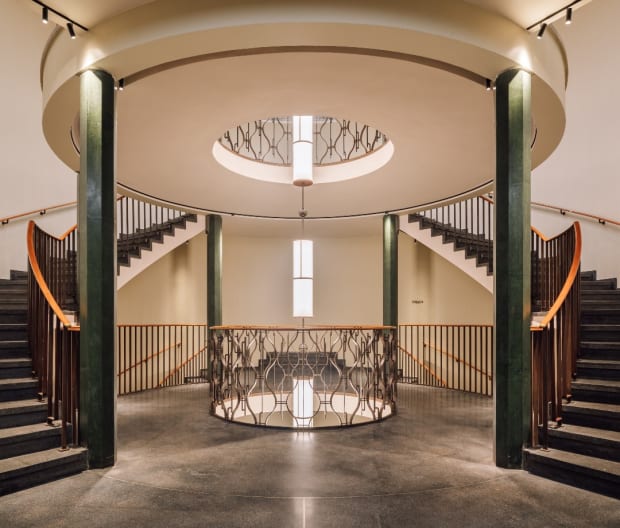
Francisco Nogueira
Sommerro worked with the city antiquarian to preserve landmark features and tapped LPO Architects and GrecoDeco—a Brooklyn, NY-based interior design firm helmed by Adam Greco and Alice Lund, whose projects include the Ned Hotel in London—to take on the renovation project. Sommerro opened to the public in September 2022.
"We wanted to capture Norwegian-ness," Adam Greco says, no easy feat for two foreign designers. "There’s not much surviving from the 20s and 30s in Oslo, but the goal was to make Sommerro feel like it had always been there."
To create a portal to this era without being irreverent, they needed to get to know the culture, so they spent a lot of time in hotels, museums, archives, and nature.
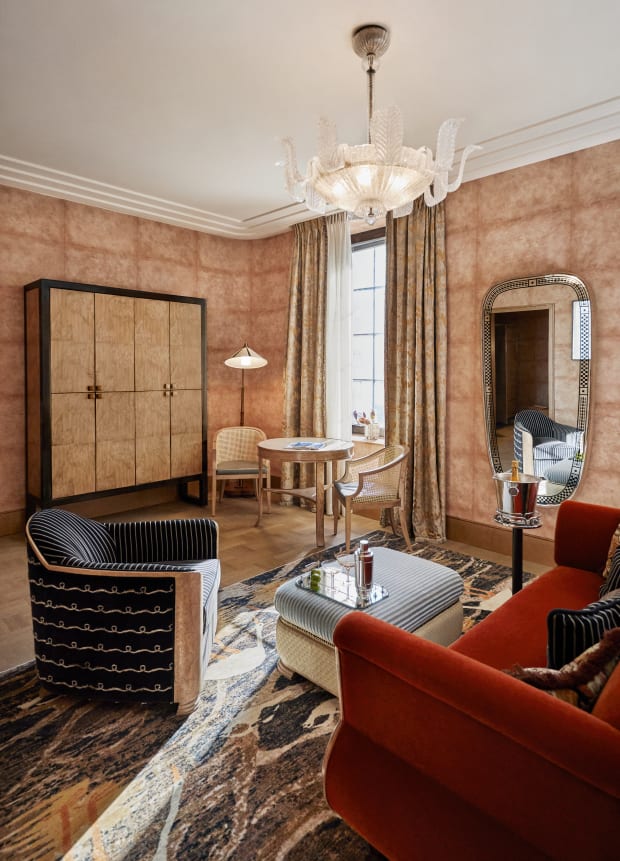
Lars Petter Pettersen
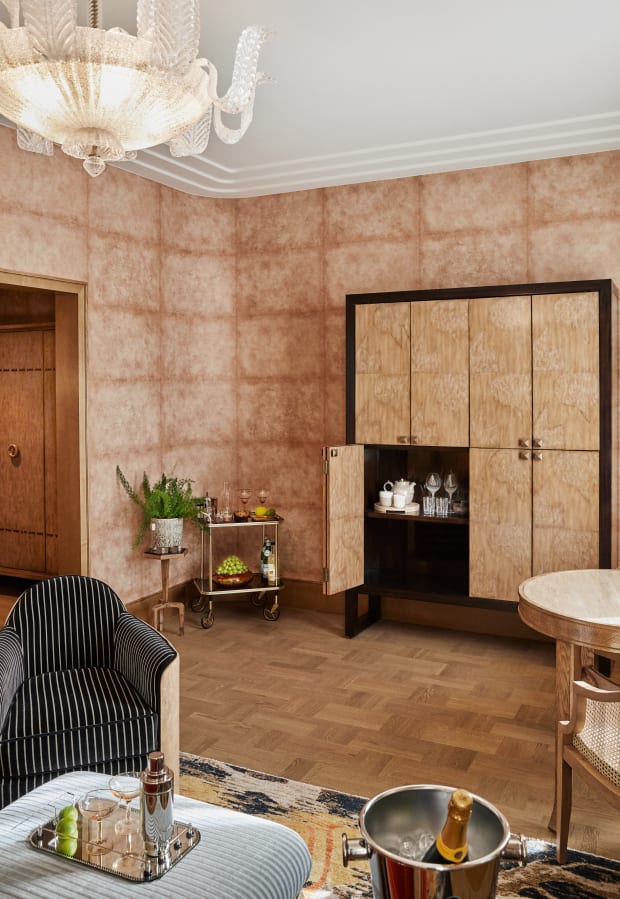
Lars Petter Pettersen
"Norwegians are really obsessed with their ingredients—cod and langoustines from Lofoten, seaweed from the harbor," Greco says. "In the food world, they’re really doing it. They’re creating a new cuisine with traditional ingredients. That was our approach with Sommerro."
While Scandinavian design is well-known for being minimal, clean, and mostly monochromatic, they wanted Sommerro to reflect Norwegian folklore and history as it was done in Gerhard Munthe’s “fairtytale room” at the Holmenkollen Tourist Hotel and Oslo Rådhus (City Hall). The latter took 50 years to complete and was an amalgamation of works form top artists and designers, a feverish mix of marble and frescoes.
"It was a declaration," Greco says. "It was their way of saying, 'This is us.' We wanted to build aesthetic similarities: color combinations, forms, details. We wanted it to feel familiar without feeling retro, something foggy like déjà vu. It’s unsettling but in a pleasant way."
In the bedrooms (choose among loft, standard, superior, deluxe, junior suite, and suite), that's achieved by using rich textiles like velvet and leather; commissioning bespoke Murano chandeliers; pairing unexpected hues (coral, navy, tangerine, pistachio green, and lilac); playing with patterns by selecting textured wallpaper that seems to vibrate, hand-knotted rugs with folkloric motifs, and black-and-pink checkered tiles in the bathroom; and choosing statement pieces of furniture: burnished wood nightstands, grand four-post oak bedframes, and intricate headboards. Rooms boast Marshall speakers, blush pink bathrobes in the wardrobe, Byredo products in the bath, and smart lighting systems to complement mood and time of day.
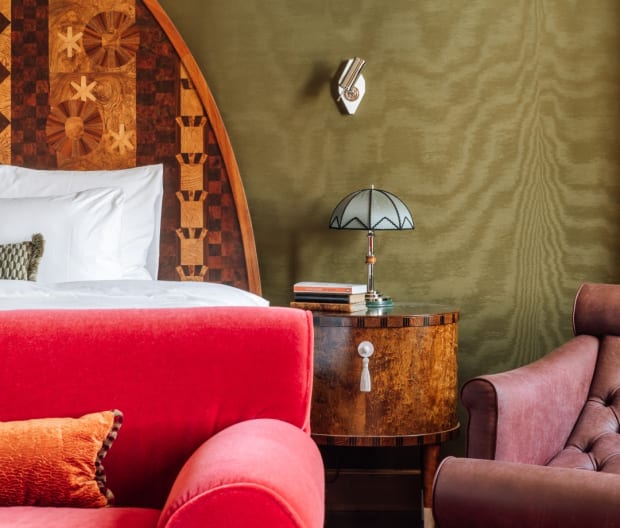
Francisco Nogueira
Greco and Lund knew it worked when they got compliments like "This place makes me proud to be Norwegian" and critiques saying the line between what was new and old was indistinguishable from a historic perspective.
Sommerro is a layer cake of Norwegian references baked inside. The icing on top is exceptional hospitality and a keen focus on experience as a whole.
“What we’ve managed to create is a house, rather than a hotel, where the historical elements of the building really complement new-age ambiance that roots guests firmly in the present,” adds Jarle Moen, managing director of Sommerro.
The Sommerro Experience
Ekspedisjonshallen (Expedition Hall)
When you walk through the entrance, there's an espresso bar, Kafè Lucy, to your left, then reception is sectioned off behind a wall to your right. Its offset location means locals traipsing in for brunch, afternoon tea, or a nightcap don't get caught in the commotion of check-in and out; instead, they have direct sightlines into Ekspedisjonshallen, Expedition Hall. The fresco on the back wall, done by Norwegian artist Per Krohg, is original and depicts the emergence of electricity. It shares center stage with a sunken bar (where locals used to come to pay their bills).
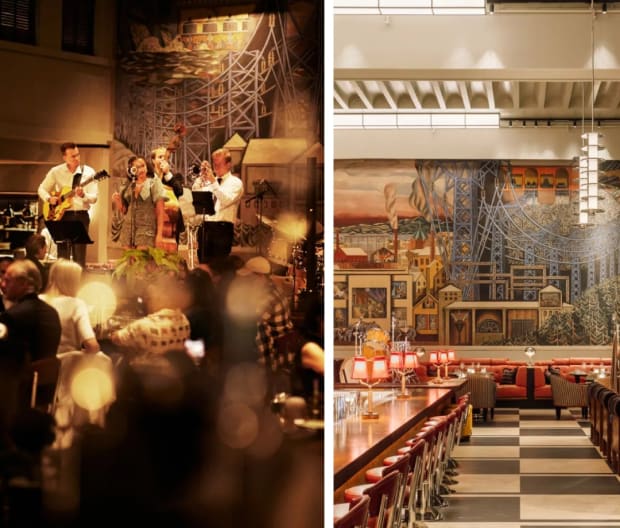
Francisco Nogueira
As you'd imagine, Sommerro is brimming with visual Easter eggs.
"The finishing on the wall of the bar is inspired by the Art Deco Expedition in Paris in 1925," Greco says. "Norway submitted its own designs for display and one of the subjects it concentrated on was book jackets— leather engraving, embossing, and guilding. We found some cool patterns from one of the displays and created the bar as an homage to that with different veneers and metallic patterns."
As far as thSommerro taps into the human desire to feel connected. This isn't a half-empty dining room of out-of-towners. The atmosphere buzzes. The house jazz band, part of Sommerro's Culture Program, plays daily, keeping the heartbeat of the room thrumming beneath the chatter of a full house.
Locals commingle with friends as well as other well-to-do diners. They work the room as if this were a party. Solo business travelers aren't siphoned off from the action: They feel a part of it all as they saddle up at the bar next to pairs of business associates and lovers, Negroni in hand.
The overall effect Sommerro engenders is that of a fantasy.
"You feel like you’re in a film," Greco says. "You can disappear in there, but at the same time it’s very open, democratic, and not pretentious at all."
While Sommerro is palatial and you can certainly get lost in its hallways, keeping it intimate and not intimidating was top of mind.
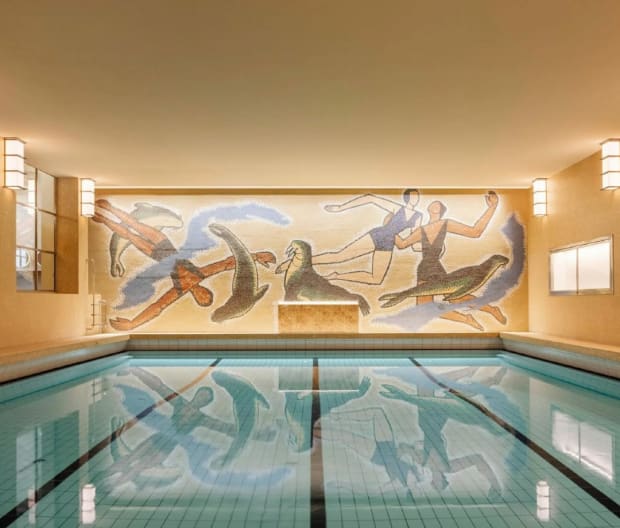
Courtesy Image
Vestkantbadet (Spa)
It might seem odd that an electrical company built a bath in its basement, but spa culture is paramount across all of Scandinavia, and the building served as a public commonplace. The original public baths, treatment rooms, and locker room from the 30s have been restored (note how the door frames are narrower and shorter than modern day).
Seeking an unofficial cure for jet lag? Go to the gym for a quick 5K on the treadmill. The sprawling 4,000-square-foot space is packed with state-of-the-art equipment that would make an elite athlete shed tears of joy.
Shower off in the locker room, then do a few laps in the pool. Do some backstroke to admire another one of Per Krohg's mosaics festooned on the wall.
Make sure you book a treatment in advance, then go to reception and wait for your specialist. I highly recommend a sport massage, but you can peruse a menu of offerings for face and body, including a sleep treatment, aromatherapy massages, and facials with specialty accoutrements designed by renowned dermatologist Dennis Gross.
Once your muscles have been manipulated into submission, head back to the spa to take advantage of the steam room, sauna, and plunge pool. The contrast therapy (hot to cold) helps stimulate circulation and promotes better sleep.
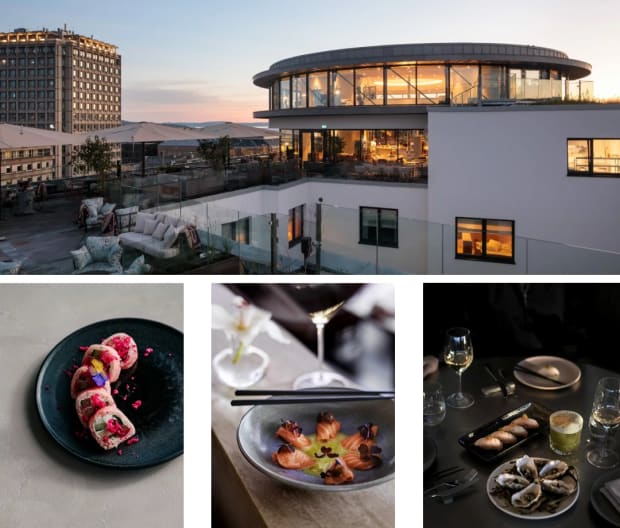
Courtesy Images
Dining at Sommerro
"Sommerro is the first hotel of its kind to introduce a multi-outlet concept in the city, with each of our carefully curated bar and restaurant concepts offering distinct menus, moods, and atmospheres," Moen says. "The fact we are able to offer everything from a classic brasserie to sushi with a Nordic twist is a highlight in itself, and our food and beverage team pushes the limits every day to ensure an innovative dining experience unlike anything else in Oslo."
TAK Oslo
Run by award-winning chef Frida Ronge, Tak Oslo is the city's only rooftop restaurant and it's became a hot spot for locals. The Nordic-Japanese restaurant showcases Norwegian ingredients prepared with Japanese techniques (think scallops, sashimi, crispy duck) as well as a chef's choice menu. Try the brunost (Norwegian brown cheese, a fudge-like, caramel-flavored cheese) ice cream with star anise, chocolate miso caramel, and caramelized rice for dessert. Sip on sake or a craft cocktail to complement the meal; Sommerro has a nice array of non-alcoholic choices, too.
Izakaya
Ronge is also the mastermind behind Sommerro's more casual cocktbail bar, Izakaya. It's set on the seventh floor of the hotel and is centered on a menu of street food-inspired small bites like panko-fried peking duck wings, oysters, and reindeer tataki.
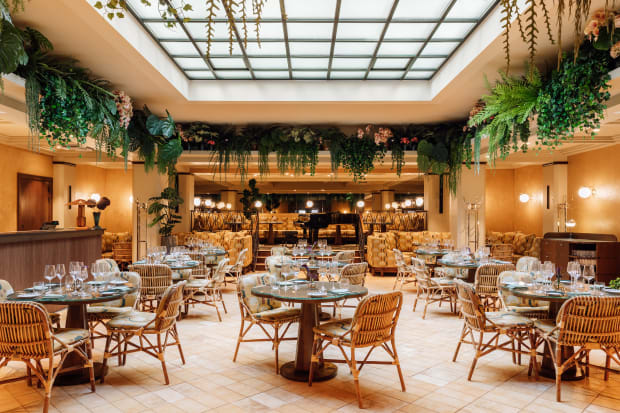
To Søstre
Afternoon tea might feel resolutely British, but it gets a more laissez-faire attitude and approach at Sommerro. Natural light floods the room, greenery drapes from the ceiling, cane chairs feature whimsical upholstery inspired by Asbjørnsen & Moe’s fairytale "East of the Sun and West of the Moon," and a self-playing Steinway Grand Piano serves as the space's soundtrack. The seasonal menu flips the switch by serving finger sandwiches first followed by scones and sweets, as well as the option to pair food with tea, bubbles, non-alcoholic concoctions, and "tipsy" tea.
Plah & Ahaan
An Oslo favorite, Plah & Ahaan brings elevated Thai cuisine to the ground floor of Sommerro. Opt among a six-course feast (appetizers, salad, soup, shellfish/fish, meat, and dessert), a six-course vegetarian alternative, or a three-course theater meal. Wash it all down with an Asian beer.
All Eyes on the Future
Clean energy has always been a through-line for Oslo Lysverker (it primarily used hydro power) and now Sommerro.
"Our mission is to create a house that will last for decades, including our latest project, Villa Inkognito, which will offer visitors accommodation in an eleven–suite private villa, set to open in April 2023," Moen says.
The villa was part of the original building, so they reused as many materials as possible in the renovation. Moreover, Sommerro is powered by 100 percent renewable energy, has eradicated bottled water on the premises, and mostly uses seasonal ingredients in-house.
"We also have different collaborations in place with our neighbors, including Sisters in Business, a social entrepreneur that employs female immigrants to recreate textiles and repair broken items," Moen adds. "Just like Oslo Lysverker used to do, we're on a mission to give back to the community and create a positive force in Frogner."
Getting There
To get from Oslo Airport to downtown Oslo, take The Airport Express Train (Flytoget), Norway’s high-speed train. It runs every 10 minutes, and the travel time to Nationaltheatret station is roughly 30 minutes, making transport to and fro Oslo Airport a breeze. You can walk to Sommero from Nationaltheatret Station faster than it takes to make kokekaffe, Norway’s famed steeped coffee. Mosey around: You’re in Frogner, an upscale, residential district in Oslo’s West End.
The neighborhood is one of the city’s oldest, peppered with museums, galleries, and attractions like the Royal Palace and Frogner Park. Be sure to stroll Aker Brygge wharf, brimming with eateries and an eyeful of Oslo Fjord. The Munch Museum is not to be missed. Grab an open-faced sandwich from Munch Deli & Café on the ground floor before you tour the palatial space.
When you're done, head back to the warm embrace of Sommerro. The neighborhood hotel makes you feel like you're coming home, even if home is thousands of miles away.
from Men's Journal https://ift.tt/7CnjF2U
via IFTTT
